Bats are the second most diverse mammal order, second only to rodents, with over 1,400 species described. Bats have incredible adaptations to accommodate their high-flying, nocturnal lives, from five-foot-wide flying foxes to microbats that fit in the palm of your hand. Here are 31 awesome bat species that we have spotted at different zoos around the U.S.
Barbastelle Bat
Table of Contents
Western barbastelle – BARBASTELLA BARBASTELLUS
- Class: Animals with Milk Glands (Mammalia)
- Subclass: True Mammals (Eutheria)
- Order: Hand Wing (Chiroptera)
- Family: Vespertilionidae.
- The Name “Bat”: “Bat” comes from Old Norse “ledhrblaka,” “leather flapper.” It became “bakka” and then “bat.”
- Location: Middle Europe.
- Habitat: Caves and trees, prefer forests and woodlands.
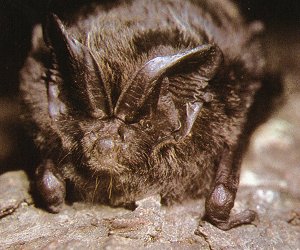 This small bat has a flat face with long broad ears, which are notched on the outer edge. There is a pointed tragus (ear flap) half the height of the ear. Its fur is relatively long and blackish, with light tips giving a grizzled appearance. The length of this bat is about 1.8 in with the forearm extending 1.6 in. It weighs 0.2 to 0.3 oz.
This small bat has a flat face with long broad ears, which are notched on the outer edge. There is a pointed tragus (ear flap) half the height of the ear. Its fur is relatively long and blackish, with light tips giving a grizzled appearance. The length of this bat is about 1.8 in with the forearm extending 1.6 in. It weighs 0.2 to 0.3 oz.
Behavior: The western barbastelle is a solitary bat, although small colonies of five or six are sometimes seen. Its summer roosts are under the bark of trees or crevices in the walls of buildings, while in the winter it hibernates in caves or occasionally in hollow trees. It may migrate up to 180 miles in autumn and spring. When active, the barbastelle emerges from its roost at the onset of dusk to forage until about midnight, when it rests for several hours and then resumes its flight again at dawn. It flies slowly and usually very low to the ground. Barbastelles eat insects while flying and will also hang head-down in a convenient spot to eat passing insects.
Reproduction: Reproductive habits are unknown. The young, either one or twins, are born in the summer.
Bentwing bat
Western barbastelle – BARBASTELLA BARBASTELLUS
- Class: Animals with Milk Glands (Mammalia)
- Subclass: True Mammals (Eutheria)
- Order: Hand Wing (Chiroptera)
- Family: Vespertilionidae.
- Location: Middle Europe.
- Habitat: Caves and trees, prefer forests and woodlands.
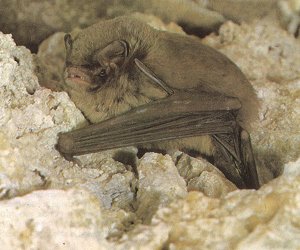 This small bat has a flat face with long broad ears, which are notched on the outer edge. There is a pointed tragus (ear flap) half the height of the ear. Its fur is relatively long and blackish, with light tips giving a grizzled appearance. The length of this bat is about 1.8 in with the forearm extending 1.6 in. It weighs 0.2 to 0.3 oz.
This small bat has a flat face with long broad ears, which are notched on the outer edge. There is a pointed tragus (ear flap) half the height of the ear. Its fur is relatively long and blackish, with light tips giving a grizzled appearance. The length of this bat is about 1.8 in with the forearm extending 1.6 in. It weighs 0.2 to 0.3 oz.
Behavior: The western barbastelle is a solitary bat, although small colonies of five or six are sometimes seen. Its summer roosts are under the bark of trees or crevices in the walls of buildings, while in the winter it hibernates in caves or occasionally in hollow trees. It may migrate up to 180 miles in autumn and spring. When active, the barbastelle emerges from its roost at the onset of dusk to forage until about midnight, when it rests for several hours and then resumes its flight again at dawn. It flies slowly and usually very low to the ground. Barbastelles eat insects while flying and will also hang head-down in a convenient spot to eat passing insects.
Reproduction: Reproductive habits are unknown. The young, either one or twins, are born in the summer.
Big brown bat
Big brown bat – EPTESICUS FUSCUS
- Class: Animals with Milk Glands (Mammalia)
- Subclass: True Mammals (Eutheria)
- Order: Hand Wing (Chiroptera)
- Family: Vespertilionidae.
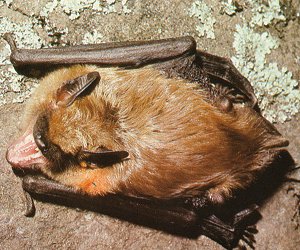 A bat of medium size with a dark, broad muzzle; simple nose; ears of moderate length, with rounded tips and blunt tragus (ear flap). The fur is long, pale to dark brown, maybe lighter on underparts. Length of head and body about 2.8 in, forearm 1.6-2 in, weight 0.5-0.8 oz; females larger than males.
A bat of medium size with a dark, broad muzzle; simple nose; ears of moderate length, with rounded tips and blunt tragus (ear flap). The fur is long, pale to dark brown, maybe lighter on underparts. Length of head and body about 2.8 in, forearm 1.6-2 in, weight 0.5-0.8 oz; females larger than males.
Location: North America south of the Arctic.
Habitat: Nearly all situations.
Behavior: Originally a forest dweller, the big brown bat has adapted to urban life and is frequently found in buildings, under bridges, and in other artificial structures, as well as in tree hollows and sometimes caves. It may roost singly or in small colonies; it rarely migrates, and then only short distances. The big brown bat forages at night, following a habitual course of the flight. It eats mostly beetles, and although many other flying insects are also taken, moths are not among them. This species hibernates in winter in the coldest parts of its range.
Reproduction: Breeding begins in autumn with fertilization delayed in hibernating females; gestation is about 2 months. The young are born from mid-May to June, usually a single offspring in western North America and twins in the East. The young are weaned and can fly when 1 month old.
Blossom bat
Southern blossom bat – SYCONYCTERIS AUSTRALIS
Possibly Endangered
- Class: Animals with Milk Glands (Mammalia)
- Subclass: True Mammals (Eutheria)
- Order: Hand Wing (Chiroptera)
- Family: Pteropodidae.
- Location: Eastern New Guinea; coastal Queensland and extreme northeastern New South Wales, Australia.
- Habitat: Tropical forests and woodlands.
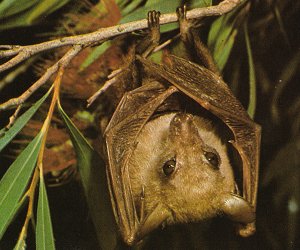 Tiny, delicate fruit bat resembling a miniature flying fox, with long, tapering snout; large eyes; tail absent. Long, reddish-brown fur. Length of head and body about 2 in, forearm 1.6 in; weight 0.4-0.7 oz.
Tiny, delicate fruit bat resembling a miniature flying fox, with long, tapering snout; large eyes; tail absent. Long, reddish-brown fur. Length of head and body about 2 in, forearm 1.6 in; weight 0.4-0.7 oz.
Behavior: Together with the closely related genus Macroglossus, these are the smallest creatures among the Megachiroptera suborder of fruit bats. Their wingspan is under 10 inches. Queensland blossom bats rest in trees by day, hanging upside down with feet clinging to a tiny branch. They often roost singly; sometimes several are found in one tree. This species may also form sizable camps, like flying foxes, for short periods in the spring. At night as many as a dozen fly about flowering trees, including bloodwood and paperbark, feeding on nectar and pollen. Their tongues are long and narrow, with hairlike papillae forming a brush near the tip. Southern blossom bats may help pollinate trees as their relatives in Indonesia are known to do. The southern species is not exclusively a nectar feeder; it also eats fruit such as wild figs.
Reproduction: Its breeding habits are unknown.
Bulldog bat
Fisherman bat, bulldog bat – NOCTILIO LEPORINUS
- Class: Animals with Milk Glands (Mammalia)
- Subclass: True Mammals (Eutheria)
- Order: Hand Wing (Chiroptera)
- Family: Noctilionidae.
- Location: Mexico to northern Argentina, West Indies.
- Habitat: Tropical and subtropical forests; woodlands and rocky cliffs near inland waters or the sea.
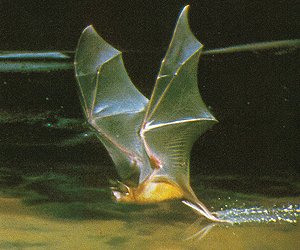 A large, robust bat with a wedge-shaped head and pointed muzzle; large, pointed eas; wrinkled upper lip; tail about half as long as the tail membrane. Fur short; dorsally bright reddish yellow in males, gray or brown in females; lighter beneath. Length of head and body about 4 in, forearm 3.2 in; weight 1.4-2.5 oz.
A large, robust bat with a wedge-shaped head and pointed muzzle; large, pointed eas; wrinkled upper lip; tail about half as long as the tail membrane. Fur short; dorsally bright reddish yellow in males, gray or brown in females; lighter beneath. Length of head and body about 4 in, forearm 3.2 in; weight 1.4-2.5 oz.
Behavior: Fisherman bats are gregarious; several dozen often roost together by day in caves, rock crevices, or hollow trees, frequently shared with other species of bats. In the late afternoon and at night, they feed upon small fish caught by gaffing with the bats’ large, sharp, curved claws. By echolocation or sonar, the bats detect the ripples caused by fish swimming near the water’s surface. The strong hind legs and large feet of fisherman bats are modifications to their feeding habits. They can swim well, using their wings as oars. These bats also eat insects and aquatic crustaceans.
Reproduction: The single young may be born during the period December-March and possibly later.
Epaulet bat
Gambian epaulet bat – EPOMOPHORUS GAMBIANUS
Possibly Endangered
- Class: Animals with Milk Glands (Mammalia)
- Subclass: True Mammals (Eutheria)
- Order: Hand Wing (Chiroptera)
- Family: Pteropodidae.
- Location: Central Africa below the Sahara.
- Habitat: Open woodland and savanna, but occasionally the rain forest.
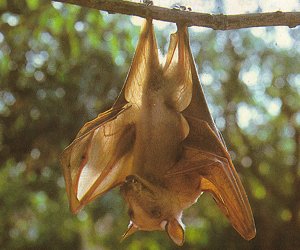 This bat is of medium size, with a long, doglike muzzle and small rounded ears. The fur is soft, light, or reddish-brown with large white tufts (“epaulets”) on the shoulders of males. It also has white patches at base of its ears. Its length not including the tail is about 6.3 in, with a forearm of about 3.3 in, and it weighs 3.5 to 5.5 oz.
This bat is of medium size, with a long, doglike muzzle and small rounded ears. The fur is soft, light, or reddish-brown with large white tufts (“epaulets”) on the shoulders of males. It also has white patches at base of its ears. Its length not including the tail is about 6.3 in, with a forearm of about 3.3 in, and it weighs 3.5 to 5.5 oz.
Behavior: This species derives its name from the showy white shoulder patches on the males which can be emphasized by the males. The function of this show is unknown, but it is believed to be sexual signaling. Gambian epaulet bats roost during the day in mango or other trees, or in bamboo reeds. They hang upside down alone or in small groups of up to twenty. This bat feeds on fruit, such as mangos and wild figs, but prefers to eat the nectar of baobab, sausage tree, and locust-bean trees. The evidence suggests that certain flowering trees depend upon this bat for pollination, and in turn, the bat’s distribution might be linked to the abundance of such flowering, nectar-producing trees. Perhaps a symbiotic relationship.
Reproduction: Unknown.
False vampire bat
African false vampire, heart-nosed bat – MEGADERMA COR
Possibly Endangered
- Class: Animals with Milk Glands (Mammalia)
- Subclass: True Mammals (Eutheria)
- Order: Hand Wing (Chiroptera)
- Family: Megadermatidae.
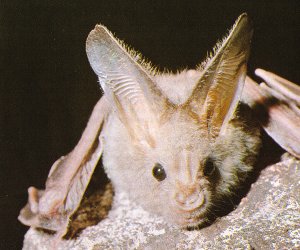 A bat of medium size, with very large ears, joined across the top of the head; relatively large eyes; heart-shaped noseleaf; no external tail. Pelage (fur) long, fine, blue-gray. Length of head and body about 3 in, forearm 2.2-2.4 in; weight 1-1.8 oz.
A bat of medium size, with very large ears, joined across the top of the head; relatively large eyes; heart-shaped noseleaf; no external tail. Pelage (fur) long, fine, blue-gray. Length of head and body about 3 in, forearm 2.2-2.4 in; weight 1-1.8 oz.
Location: Throughout east Africa.
Habitat: Dry acacia bushland.
Behavior: Sometimes placed in a genus of its own, Cardioderma, and closely related to the 2 species of bat-eating bats of India and Australia, the African false vampire is primarily an insect-eater. Much of its diet consists of flightless insects, which the bat sees from its hunting roosts on low branches or bushes, flies to the ground to capture, and returns to its perch to devour. The bats begin hunting at dusk and are low fliers. They rest during the day, remaining alert, hanging in caves. Widely spaced individuals roost in small colonies and rarely share their quarters with bats of other species, whose death remains have been found under their roosts (suggesting that the false vampires killed and ate them).
Reproduction: A protracted breeding season apparently peaks in August; gestation is about 3 months. The single young cling to its mother for some 2 months.
Flying fox bat
Indian flying fox – PTEROPUS GIGANTEUS
- Class: Animals with Milk Glands (Mammalia)
- Subclass: True Mammals (Eutheria)
- Order: Hand Wing (Chiroptera)
- Family: Pteropodidae.
- Location: India.
- Habitat: Prefers tropical and subtropical forests.
Description: This is a very large bat with a foxlike head and ears, large eyes, two claws on its wings, and no tail. Its fur is coarse, with a reddish-brown head with a dark muzzle, the neck and shoulders are yellow, the back is brown, and it is yellowish-brown on the belly. Its length is about 9 in, with a forearm of about 6.8 in, and it weighs 20 to 22 oz.
Behavior: With a wingspan up to 4 feet, this is one of the largest of the 67 species of flying foxes. The largest has a wingspan of five feet. This Indian species is commonly seen during the day roosting in large colonies, or “camps,” high up in the trees. They spend the morning chattering and jockeying for preferred roosting sites on the branches, where they hang by their feet. They pass most of the day asleep with their wings wrapped around themselves. At night they fly to favorite foraging areas, where they feed in the trees on all sorts of ripe fruit (except citrus). The flying fox swallows only the juice, spitting out the pulp.
Reproduction: A single young is born in February, after a gestation of 140 to 150 days, and clings to its mother for about two months until nearly full size.
Free-tailed bat
Brazilian free-tailed bat – TADARIDA BRASILIENSIS
- Class: Animals with Milk Glands (Mammalia)
- Subclass: True Mammals (Eutheria)
- Order: Hand Wing (Chiroptera)
- Family: Molossidae.
- Location: Southern half of U.S. to mid-Chile and Argentina.
- Habitat: Scrub and woodlands.
A small, robust, gray-brown bat with long tail, half of its length free beyond the tail membrane; long, stiff hairs on the toes; short, broad muzzle with wrinkled lips; ears bonnet-shaped. Length of head and body 1.9-2.6 in, forearm 1.5-1.8 in; weight 0.4-0.7 oz.
Behavior: Summer nursery colonies of this highly gregarious bat number up to 10 or 20 million per cave in Texas, Oklahoma, New Mexico, and Arizona. At one time, nearly 9 million inhabited the Carlsbad Caverns; now only some 250,000 bats summer there. These vast populations migrate as far as 800-1 000 miles into Mexico for the winter, whereas in southeastern and western North America, the free-tails remain throughout the year, roosting in buildings and possibly hibernating in cold weather. Flying 35 to 50mph, freetails emerge at dusk to feed on small moths.
Reproduction: Gestation is 77-84 days in Florida, about 100 days in California (unknown for other parts of the range). The single offspring is born in June-July and is able to fly in about 5 weeks.
Hairless bulldog bat
Hairless, or naked bulldog bat – CHEIROMELES TOROUATUS
Endangered
- Class: Animals with Milk Glands (Mammalia)
- Subclass: True Mammals (Eutheria)
- Order: Hand Wing (Chiroptera)
- Family: Molossidae.
- Location: Southeast Asia.
- Habitat: Tropical forests.
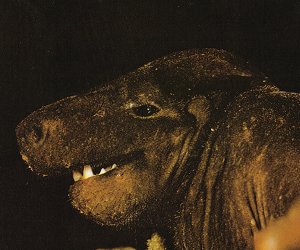 A medium-sized bat with small ears, long muzzle, and simple nose; tail long, thick, and extending well beyond tail membrane. Loose, heavy, dark gray or brown skin is nearly naked, with only sparse hairs around the scent gland on the throat, and bristles on the first toe. Length of head and body 5.2-5.8 in, forearm 3.2-3.4 in; weight about 6.3 oz.
A medium-sized bat with small ears, long muzzle, and simple nose; tail long, thick, and extending well beyond tail membrane. Loose, heavy, dark gray or brown skin is nearly naked, with only sparse hairs around the scent gland on the throat, and bristles on the first toe. Length of head and body 5.2-5.8 in, forearm 3.2-3.4 in; weight about 6.3 oz.
Behavior: In addition to its hairless condition, the naked bulldog bat is peculiar in having a pocket of skin along its sides, into which its wings are folded when the bat rests. The haired gland on its throat produces a strong, foul odor. The bat cleans its skin with the brushlike bristles on its big toes, which are opposable to the others, and has a flat nail instead of a claw. These bats are gregarious, having been found in colonies of nearly 1000 roosting in hollow trees or sometimes caves, often with other free-tailed bats. Emerging at dusk, they fly fast and purposefully, foraging for flying termites above the forest treetops or in clearings.
Reproduction: The breeding habits of this species are not known.
Hammer-headed bat
Hammer-headed bat – HYPSIGNATHUS MONSTROSUS
Possibly Endangered
- Class: Animals with Milk Glands (Mammalia)
- Subclass: True Mammals (Eutheria)
- Order: Hand Wing (Chiroptera)
- Family: Pteropodidae.
- Location: Senegal, through Congo basin, to southwest Sudan.
- Habitat: Wet, tropical, lowland forest; riverine woods; mangrove swamps.
This large fruit bat has short brown fur over its body and head, with little on its wing membrane. The head is large and rectangular, with pointed ears, an inflated nose, and thick, folded lips. It has no tail. Length of head and body about 8.5-11.3 in, forearm 4.8-5.5 in, weight 8-16 oz; females smaller.
Behavior: This species, in a genus by itself, is the largest bat in Africa and is immediately recognized by its peculiarly raised muzzle. More pronounced in males, this feature, in combination with its huge larynx, thick vocal cords, and special air chambers in the throat and head all serve to resonate the voice. At different seasons in various parts of its range, male hammer-headed bats spend the night calling incessantly, about every second uttering a loud, monotonous, and disturbing croak or clanging sound, something like Kwok, that can be heard over a great distance. Several males may call in chorus; the purpose is thought to be to attract females. By day the hammer-headed bat, singly or in small groups, roosts in shady trees. It feeds at night, sucking the juice of tropical fruits.
Reproduction: Breeding may be year-round, though births peak in February and July. One young is usual.
Hoary bat
Hoary bat – LASIURUS CINEREUS
Endangered
- Class: Animals with Milk Glands (Mammalia)
- Subclass: True Mammals (Eutheria)
- Order: Hand Wing (Chiroptera)
- Family: Vespertilionidae.
- Location: Throughout the Americas from southern Canada to central Chile and Argentina; Hawaii; Hispaniola.
- Habitat: Forests and woodlands.
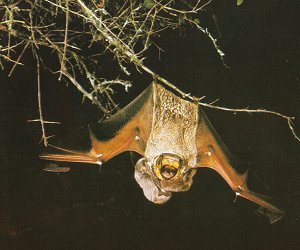 A heavy-bodied bat of medium size with short, rounded ears edged with black; simple nose; tail membrane dorsally furred. Pelage thick, face and throat buff to yellow, body brown with hairs tipped white, giving a frosted appearance. Length of head and body about 3.4 in, forearm about 2 in; weight 0.7-1.2 oz.
A heavy-bodied bat of medium size with short, rounded ears edged with black; simple nose; tail membrane dorsally furred. Pelage thick, face and throat buff to yellow, body brown with hairs tipped white, giving a frosted appearance. Length of head and body about 3.4 in, forearm about 2 in; weight 0.7-1.2 oz.
Behavior: Largest bat in eastern North America (and the only bat native to Hawaii), this species breeds in its northern summer range and winters in the southern U.S. and possibly in Mexico. Some South American populations may also migrate. Its complex migratory habits are incompletely known. Vagrants, probably blown off course, have been found in Iceland, Orkney, and Bermuda. Individuals remaining far north in winter may hibernate during the coldest weather. The hoary bat, usually solitary, roosts in leaf clusters in trees, at 10-15 feet above the ground, and emerges in the late evening to forage. Fast-flying, these bats catch and eat insects (mainly moths) on the wing.
Reproduction: In North America, the young are born in May-June, after what is probably an 8-month gestation period; there are usually 2 per litter (occasionally 1).
Horseshoe bat
Greater horseshoe bat – RHINOLOPHUS FERRUMEOUINUM
Endangered
- Class: Animals with Milk Glands (Mammalia)
- Subclass: True Mammals (Eutheria)
- Order: Hand Wing (Chiroptera)
- Family: Rhinolophidae.
- Location: Southern Europe.
- Habitat: Caves and woodlands; montane areas in warm regions.
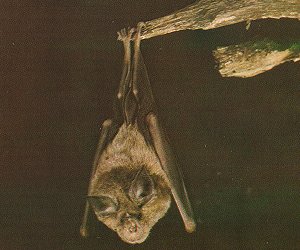 A bat of medium size, distinguished by its large, pointed ears and flattened face; a horseshoe-shaped fleshy disc surrounds the nostrils, forming the base of a pointed noseleaf. Pelage (fur) fine, silky, tawny brown in color, sometimes grayish. Length of head and body about 2.5 in, forearm 2.2 in; weight 0.5-1 oz.
A bat of medium size, distinguished by its large, pointed ears and flattened face; a horseshoe-shaped fleshy disc surrounds the nostrils, forming the base of a pointed noseleaf. Pelage (fur) fine, silky, tawny brown in color, sometimes grayish. Length of head and body about 2.5 in, forearm 2.2 in; weight 0.5-1 oz.
Behavior: The peculiar horseshoe noseleaf acts as a megaphone for the ultrasonic echolocating cries of this species, which, unlike many other bats, emits such sounds through the nostrils rather than the mouth. Its larynx extends into the back of the nasal passages. It forages at night, often taking large beetles and other insects from the ground. Daytime retreats are usually caves, mines, hollow trees, or buildings; during the winter this species hibernates in caverns where it is found hanging in small clusters.
Reproduction: Although breeding occurs in the autumn, fertilization is delayed until spring; actual gestation is about 6 weeks. The single offspring is born in June-July and by autumn attains adult size and can fly. While little, it clings to its mother’s fur and to her false teats – 2 abdominal fleshy protuberances.
Lattice-winged bat
Wrinkle-faced, or lattice-winged bat – CENTUREO SENEX
Endangered
- Class: Animals with Milk Glands (Mammalia)
- Subclass: True Mammals (Eutheria)
- Order: Hand Wing (Chiroptera)
- Family: Phyllostomatidae.
- Location: Central America.
- Habitat: Tropical and subtropical forests and woodlands.
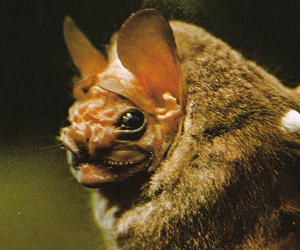 A small, brownish bat with a white spot on each shoulder. Short muzzle; the crown of the head raised; the naked face covered with wrinkled skin; wing membranes marked with numerous transverse parallel dark bands. Length of head and body 2.2-2.8 in, forearm about 1.8 in; weight up to 1 oz.
A small, brownish bat with a white spot on each shoulder. Short muzzle; the crown of the head raised; the naked face covered with wrinkled skin; wing membranes marked with numerous transverse parallel dark bands. Length of head and body 2.2-2.8 in, forearm about 1.8 in; weight up to 1 oz.
Behavior: The grotesque facial appearance immediately sets this species apart from all other bats. Most of its close relatives have a noseleaf, but instead, the wrinkle-faced bat has a mass of fleshy growths covering its face. When roosting during the day, the bat covers its face with a mask of the skin by drawing it upward from its attachment at the chin and hooking it on a protrusion at the top of its head. Even the ears are thus covered. In some individuals there are 2 translucent patches in the mask, allowing the bat to perceive light or moving forms. Wrinkle-faced bats roost among the leaves of trees, usually singly or in small groups of fewer than a dozen. They are fruit-eaters.
Reproduction: One offspring is usual and females breed more than once each year; the gestation period is unknown.
Leaf-nosed bat
Commerson’s leaf-nosed bat – HIPPOSIDEROS COMMERSONI
- Class: Animals with Milk Glands (Mammalia)
- Subclass: True Mammals (Eutheria)
- Order: Hand Wing (Chiroptera)
- Family: Rhinolophidae.
- Location: Throughout Africa south of the Sahara.
- Habitat: Savanna and woodlands; occasionally forests.
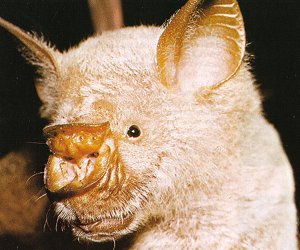 A large, robust bat with short tail enclosed in the tail membrane; leaf-shaped ears and broad, rounded noseleaf on base of 3 or 4 fleshy leaflets. Pelage (fur) may be either of 2 color phases: red-orange or sepia-brown above, gray or white beneath. Length of head and body about 4.3 in, forearm 4 in; weight 4.6 oz.
A large, robust bat with short tail enclosed in the tail membrane; leaf-shaped ears and broad, rounded noseleaf on base of 3 or 4 fleshy leaflets. Pelage (fur) may be either of 2 color phases: red-orange or sepia-brown above, gray or white beneath. Length of head and body about 4.3 in, forearm 4 in; weight 4.6 oz.
Behavior: With a wingspan of nearly 2 feet, the giant leaf-nosed bat is one of the largest insectivorous species in Africa. It is eaten in Tanzania. Large colonies, sometimes hundreds of individuals, roost by day in caves, though hollow trees and even shrubs sometimes provide shelter. At night, Commerson’s bat flies at low levels foraging for the variety of insects upon which it feeds. It spits out the hard parts of insects, consuming only the soft portions. This bat is known to gorge on flying termites.
Reproduction: Gestation is thought to be 5 months; the single offspring is usually born in October, at the beginning of the rainy season. Although the young bat grows rapidly, it is not weaned until over 5 months of age, and only reaches sexual maturity when 2 years old.
Little brown bat
Little brown bat, little brown myotis – MYOTIS LUCIFUGUS
- Class: Animals with Milk Glands (Mammalia)
- Subclass: True Mammals (Eutheria)
- Order: Hand Wing (Chiroptera)
- Family: Vespertilionidae.
- Location: Most of Canada and the continental U.S.A.
- Habitat: Temperate forests and woodlands near freshwater.
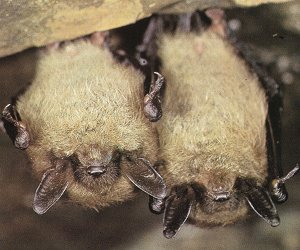 A small bat with a simple nose; moderately long ears with long, pointed tragus (ear flap); tail extending to edge of tail membrane; long hairs on toes. Fur long, silky, glossy; tan, reddish, or dark brown; paler beneath. Length of head and body 1.6-2.2 in, forearm 1.3-1.6 in; weight about 0.3 oz.
A small bat with a simple nose; moderately long ears with long, pointed tragus (ear flap); tail extending to edge of tail membrane; long hairs on toes. Fur long, silky, glossy; tan, reddish, or dark brown; paler beneath. Length of head and body 1.6-2.2 in, forearm 1.3-1.6 in; weight about 0.3 oz.
Behavior: This very common nocturnal species eats flying insects caught on the wing. Seasonal in habit, little brown bats roost in colonies of up to several thousand, choosing warm sites such as attics or caves in summer. They breed in late summer and autumn, though fertilization is delayed until spring, and migrate up to 290 miles to form winter colonies in caves where temperatures remain just above freezing. There they hibernate, rousing themselves about every 2 weeks to move to more favorable positions.
Reproduction: Again migrating in spring, the females form large maternity colonies, males usually roosting alone. After a gestation of 50-60 days, the single offspring is born May-July. It flies and forages as an adult when 1-month-old.
Long-eared bat
Common long-eared bat – PLECOTUS AURITUS
- Class: Animals with Milk Glands (Mammalia)
- Subclass: True Mammals (Eutheria)
- Order: Hand Wing (Chiroptera)
- Family: Vespertilionidae.
- Location: From England eastward as far as Japan.
- Habitat: Forests and woodlands.
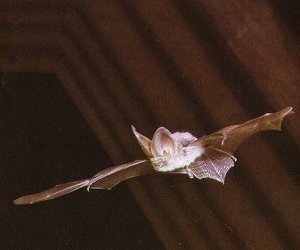 Of small size, this delicate bat has a moderately long muzzle bearing a pair of protuberances above the nose; extremely long ears joined across the forehead with a long, simple, narrowly rounded tragus (ear); tail tip-free beyond tail membrane. Fur is long, grizzled; brownish in color except for gray-white beneath. The average head and body length 1.8 in, forearm 1.6 in; weight 0.2-0.5 oz.
Of small size, this delicate bat has a moderately long muzzle bearing a pair of protuberances above the nose; extremely long ears joined across the forehead with a long, simple, narrowly rounded tragus (ear); tail tip-free beyond tail membrane. Fur is long, grizzled; brownish in color except for gray-white beneath. The average head and body length 1.8 in, forearm 1.6 in; weight 0.2-0.5 oz.
Behavior: This possibly migratory species is very common in the temperate parts of the Palearctic Region, and often roosts in colonies of 50-100 in its summer daytime retreats, such as under roofs or in hollow trees. It is generally more solitary in winter while hibernating in caves. Foraging at dusk and through the night, the long-eared bat eats moths and beetles caught in flight and captures other insects, spiders, and woodlice by hovering in trees and climbing on branches or walls.
Reproduction: Long-eared bats breed in autumn and spring. Pregnant females form nursery colonies of 100 or more in early summer, and the single young or twins are born in June-July. Four similar species of Plecotus inhabit North America.
Long-fingered bat
Bent-wing, or Schreiber’s long-fingered bat – MINIOPTERUS SCHREIBERSI
- Class: Animals with Milk Glands (Mammalia)
- Subclass: True Mammals (Eutheria)
- Order: Hand Wing (Chiroptera)
- Family: Vespertilionidae.
- Location: Southwestern Europe to Japan; throughout Africa including Madagascar; southern Asia, through the islands to Australia.
- Habitat: All situations except desert.
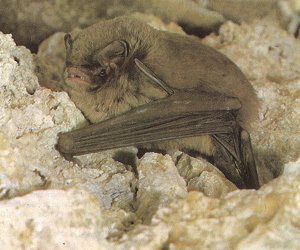 A small bat with a short, broad muzzle; ears low, wide, rounded; long second joint of the third finger. Pelage (fur) short and dense; color ranges from reddish to grayish but is generally brown. Length of head and body about 2-2.4 in, forearm 1.8 in; weight up to 0.7 oz.
A small bat with a short, broad muzzle; ears low, wide, rounded; long second joint of the third finger. Pelage (fur) short and dense; color ranges from reddish to grayish but is generally brown. Length of head and body about 2-2.4 in, forearm 1.8 in; weight up to 0.7 oz.
Behavior: The cave-dwelling bent-wing bat roosts in small clusters or large colonies up to 50,000, often sharing its quarters with bats of other species. Migrations can cover about 100-200 miles between summer and winter retreats. This bat hibernates in cold climates or otherwise curtails activity during cold weather. Foraging flights begin soon after sunset, the insect-eating bats flying high and fast.
Reproduction: Bent-wings mate in the autumn; fertilization is immediate, but the growth of embryos varies according to climate. In Europe, births are in April. In eastern Australia, young are born in December-January. In the tropics, gestation is rapid with births following in late November-December. The single offspring can fly when 7 weeks old.
Long-tongued bat
Pallas’ long-tongued bat – GLOSSOPHAGA SORICINA
Possibly Endangered
- Class: Animals with Milk Glands (Mammalia)
- Subclass: True Mammals (Eutheria)
- Order: Hand Wing (Chiroptera)
- Family: Phyllostomatidae.
- Location: Mexico south to northern Argentina.
- Habitat: Tropical and subtropical forests; woodlands.
A small, brown bat with the long, narrow snout; small eyes; short, rounded ears; simple, erect, pointed nose-leaf; very short tail with its extreme tip-free on the upper surface of the tail membrane. Length of head and body 1.9-2.5 in, forearm 1.2-1.6 in; weight about 0.3 oz.
Behavior: One of the most common Neotropical bats in warm regions, this species roosts by day in caves, mine tunnels, and buildings, often sharing its quarters with other species. It is gregarious, forming colonies of several hundred, but is also found in only small clusters; individuals roost separated from one another. A noisy, fast-flying bat, Pallas’ long-tongued bat feeds at night on nectar, fruit, and insects. Similar to the Australasian blossom bat (of an entirely distinct suborder), this species is endowed with a particularly long, narrow, extensible tongue with a brush of hairlike papillae arising from the sides at the tip. This helps in lapping nectar from flowers of plants, including calabash trees and night-blooming cacti.
Reproduction: This species may give birth to its single offspring twice each year, the seasons of birth varying geographically.
Mouse-eared bat
large mouse-eared bat – MYOTIS MYOTIS
Endangered
- Class: Animals with Milk Glands (Mammalia)
- Subclass: True Mammals (Eutheria)
- Order: Hand Wing (Chiroptera)
- Family: Vespertilionidae.
- Location: Central and southern Europe.
- Habitat: Nearly all situations.
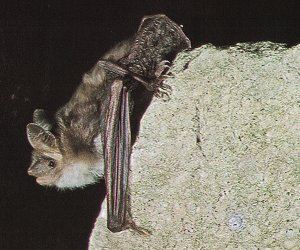 A heavily built, small bat with a simple nose; moderately long, leathery ears and long, round-tipped, simple tragus (ear flap); fairly long tail with only extreme cartilaginous tip free of tail membrane. Fur short, brown dorsally, grayish-white beneath. Length of head and body up to 3.2 in, forearm about 2.4 in; weight up to 1.4 oz.
A heavily built, small bat with a simple nose; moderately long, leathery ears and long, round-tipped, simple tragus (ear flap); fairly long tail with only extreme cartilaginous tip free of tail membrane. Fur short, brown dorsally, grayish-white beneath. Length of head and body up to 3.2 in, forearm about 2.4 in; weight up to 1.4 oz.
Behavior: Abundant on the Continent but seldom found in England, this bat is the largest of the 11 Myotis species in Europe. The genus is the most widespread in the world, with nearly 100 species recognized (over 20 of them in North America). The large mouse-eared bat eats insects caught in flight as well as beetles taken on the ground. The species is migratory, traveling up to 160 miles between its summer and winter roosts.
Reproduction: In summer, nursery colonies of several hundred inhabit buildings, tunnels, or caves; smaller winter colonies hibernate in caves. Most single offspring, rarely twins, are born in June following a gestation of 50-70 days, reaching maturity and migrating with their parents by August.
Myotis bat
Greater naked-backed bat – DOBSONIA MOLUCCENSIS
- Class: Animals with Milk Glands (Mammalia)
- Subclass: True Mammals (Eutheria)
- Order: Hand Wing (Chiroptera)
- Family: Pteropodidae.
- Location: New Guinea.
- Habitat: Prefers tropical forests and woodlands.
This is a large fruit bat with a doglike face and ears. Its wings are attached along the spine. It has a short tail, and no claw on its first finger. Its fur is brownish with black shading on the head. The length of its head and body is 7.5 to 8 in, with a forearm of 5 to 6 in, and it weighs up to 16 oz.
Behavior: This highly specialized fruit bat, the largest of the twelve species inhabiting the island region from the Philippines to the Solomons, usually roosts in caves or mine tunnels. It has also been seen hanging in mango trees. It is unique among flying foxes by having its wing membranes attached along the middle-back, thus appearing to have no hair on the back: therefore “naked.” There is indeed fur under the wings, however, which covers the bat’s back. Such extended wing mass – about 3.5 feet – apparently increases the bat’s agility in flight, as it is able to maneuver easily through the thick rain forest, which other bats of comparable size cannot manage. This species can also hover by flapping its giant wings while foraging among forest trees. Nocturnal, it eats fruit, including the native figs, and feeds on the nectar of gumtree blossoms.
Reproduction: Its breeding habits are unknown.
Particolored bat
Particolored bat – VESPERTILIO MURINUS
- Class: Animals with Milk Glands (Mammalia)
- Subclass: True Mammals (Eutheria)
- Order: Hand Wing (Chiroptera)
- Family: Vespertilionidae.
- Location: Central Europe to Siberia.
- Habitat: Forests, woodlands, and steppes.
Small and robust, a bat with short, broad, rounded ears; simple but prominent nose; long tail with tip extending beyond tail membrane. Fur short, dense; dark brown with whitish tips, giving a frosted appearance. Length of head and body about 2 in, forearm up to 1.8 in; weight about 0.5 oz.
Behavior: This hardy bat favors cold climates. Abundant in southern Sweden and central Russia, it is also common in the Alps and lives in the Himalayas to at least 10,000 feet elevation. Two vagrants, probably brought by boat, have been found in England within the past 100 years. Particolored bats roost in rock crevices and hollow trees and are often found in the walls and attics of buildings, both large summer colonies of up to several thousand bats or when hibernating in winter. They forage for insects late at night, flying back and forth or in circles 60 feet or more above the ground through their habitual hunting areas, which are open places 300-1000 feet across. Their migrations are usually only short distances between seasonal roosting sites.
Reproduction: Gestation is 40-50 days; the young, frequently twins, are born May-June.
Pinto bat
Spotted or pinto bat – EUDERMA MACULATUM
Endangered
- Class: Animals with Milk Glands (Mammalia)
- Subclass: True Mammals (Eutheria)
- Order: Hand Wing (Chiroptera)
- Family: Vespertilionidae.
- Location: Western North America from interior southern California east to New Mexico, from Montana south to Mexico.
- Habitat: Rocky cliffs and canyons; coniferous forest and woodland; scrub and desert.
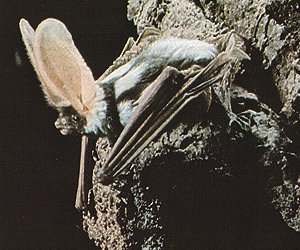 Immediately recognized by its striking coloration, this small, delicate bat is black with a contrasting white patch on each shoulder and the rump; white at base of ears; underparts with black hair tipped white. Ears are enormous, rounded at tip; tragus simple. Length of head and body 2.4-2.6 in, forearm 2 in; weight 0.4-0.7 Oz.
Immediately recognized by its striking coloration, this small, delicate bat is black with a contrasting white patch on each shoulder and the rump; white at base of ears; underparts with black hair tipped white. Ears are enormous, rounded at tip; tragus simple. Length of head and body 2.4-2.6 in, forearm 2 in; weight 0.4-0.7 Oz.
Behavior: The spotted bat is rare, perhaps a relict species, and is known from only a few dozen specimens collected since its discovery in 1890. It has been found in mixed coniferous forest at 6000-8000 feet, as well as in arid desert below sea level. It is probably solitary and roosts in crevices high up in rocky cliffs and canyons. If may hibernate in caves during winter in northern latitudes and otherwise migrate, perhaps vertically. Foraging late at night, it eats mostly moths, discarding the wings and hard parts, and occasionally consumes other insects.
Reproduction: Little is known of its reproductive cycle, but it apparently bears a single young in June (possibly in July-August in the northern parts of ifs range).
Pipestrelle bat
Common pipistrelle – PIPISTRELLUS PIPISTRELLUS
- Class: Animals with Milk Glands (Mammalia)
- Subclass: True Mammals (Eutheria)
- Order: Hand Wing (Chiroptera)
- Family: Vespertilionidae.
- Location: Western Europe to western Asia.
- Habitat: Nearly all situations.
Small and robust, this bat has a short, dark muzzle; small ears, tragus (ear flap) straight with broadly rounded tip; glandular swelling on each side of face; the tip of long-tail free from the tail membrane. Fur long, uniformly brown, maybe slightly lighter beneath. Length of head and body about 1.6 in, forearm about 1.2 in; weight 0.1-0.3 oz.
Behavior: The most abundant bat in the British Isles and one of the most common in Europe, the tiny pipistrelle roosts singly or in small colonies up to several hundred in number, often with other species. It favors hollow trees or under loose bark, buildings, under roofs, but is rarely found in caves. It forages throughout the night, and in spring and autumn may be seen flying about in midday as well, seeking small insects such as gnats and crane flies. Common pipistrellas hibernate in winter and sometimes migrate more than 1000 miles between seasonal roosting sites.
Reproduction: Most young are born in July after a gestation period of about 6 weeks, and reach sexual maturity in 2 years. A single offspring is usual in Britain; twins are common in northern and central Europe.
Rousette bat
Egyptian rousette – ROUSETTUS AEGYPTIACUS
- Class: Animals with Milk Glands (Mammalia)
- Subclass: True Mammals (Eutheria)
- Order: Hand Wing (Chiroptera)
- Family: Pteropodidae.
- Location: From Egypt south along the Nile Valley, and then over all of Africa south of the Sahara.
- Habitat: It prefers wooded areas, but is common in all habitats except the desert.
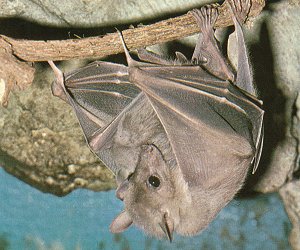 The rousette is a medium-sized fruit bat a with simple, doglike face and ears, large eyes, and a very short tail projecting beyond an incomplete tail membrane. Its brown fur is often tinged with gray. The head and body are 5.2 to 6 in. long, with the forearm extending about 3.8 in., and it weighs 3.5 to 5.0 oz.
The rousette is a medium-sized fruit bat a with simple, doglike face and ears, large eyes, and a very short tail projecting beyond an incomplete tail membrane. Its brown fur is often tinged with gray. The head and body are 5.2 to 6 in. long, with the forearm extending about 3.8 in., and it weighs 3.5 to 5.0 oz.
Behavior: Originally found in the Great Pyramid at Gizeh, this bat is also depicted in drawings on the walls of the ancient Egyptian tombs. Unlike most fruit bats, the rousette roosts in caves, tombs, and similar dark daytime shelters, often in colonies of up to several thousand individuals. Although it also has keen vision, the rousette is an exception among the other large fruit-eating bats in its ability to guide its agile flight by echolocation, or “sonar.” Nocturnally active, the rousette feeds on many kinds of soft fruits and the juice of hard fruits and certain leaves. Figs and dates form its main diet in arid regions. The bat locates its food by smell.
Reproduction: Breeding is year-round in Egypt, only twice yearly in East Africa, and just once a year in the southern regions. Gestation is about 105 days when a single young is born, but twins are not rare.
Spear-nosed bat
Spear-nosed bat – PHYLLOSTOMUS HASTATUS
- Class: Animals with Milk Glands (Mammalia)
- Subclass: True Mammals (Eutheria)
- Order: Hand Wing (Chiroptera)
- Family: Phyllostomatidae.
- Location: North and central South America.
- Habitat: Tropical forests and woodlands.
Description: Of fairly large size, a heavy-bodied bat with a short tail; short muzzle; pointed ears widely separated; large, broad, tapering noseleaf; and V-shaped groove in the lower lip. Thick fur, dark gray- or red-brown above; paler beneath. Length of head and body 4-5.2 in, forearm about 3.6 in; weight up to 3.5 oz.
Behavior: Spear-nosed bats are highly gregarious, usually roosting together in clusters in caves or tree hollows, sometimes forming colonies of several thousand individuals sharing one cave. Groups often fly together from their diurnal retreat to their evening foraging areas. This species is quite omnivorous in diet, eating fruit, possibly nectar and flowers, insects, birds, and small rodents. A large bat with a 2-foot wingspan will also attack, kill, and devour other bats. It is itself prey to an even larger cannibal bat, the false vampire, which is the largest bat in the Americas.
Reproduction: The spearnosed bat gives birth to a single offspring, apparently seasonally, either once or twice per year. Pregnant females have been captured in March and April; nursing mothers have been recorded in each month from April through August.
Tomb bat
Mauritian tomb bat – TAPHOZOUS MAURITIANUS
- Class: Animals with Milk Glands (Mammalia)
- Subclass: True Mammals (Eutheria)
- Order: Hand Wing (Chiroptera)
- Family: Emballonuridae.
- Location: Sub-Saharan Africa, including Madagascar, and the islands of Mauritius, Reunion, and Assumption.
- Habitat: Forests and woodland
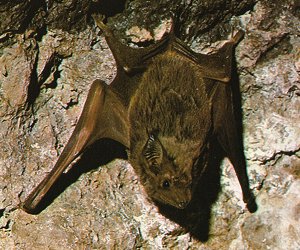 The back is grayish-brown with white speckling, but the underside of the body is almost completely white. The male has a large sac on the throat. There is also a sac or pouch at the base of the wings. The wing membranes are unusually tough. Length of head and body 3.6 in, forearm 2.4-2.6 in; weight 0.9 oz.
The back is grayish-brown with white speckling, but the underside of the body is almost completely white. The male has a large sac on the throat. There is also a sac or pouch at the base of the wings. The wing membranes are unusually tough. Length of head and body 3.6 in, forearm 2.4-2.6 in; weight 0.9 oz.
Behavior: This tomb bat lives in small groups in places not necessarily shielded from the light, such as among rocks, or hanging in trees or from walls or eaves. It emerges before nightfall to hunt, rising into the air to a height of 200-300 feet, and then slowly making its way downwards as darkness descends. It feeds on flying insects. It hibernates only in colder regions. In these parts it accumulates a large amount of fat beneath its skin as an energy reserve.
Reproduction: Reproduction may be confined to a single season where alternations in the climate are more accentuated.
Tube-nosed bat
Common tube-nosed bat – NYCTEMENE ALBIVENTER
Possibly Endangered
- Class: Animals with Milk Glands (Mammalia)
- Subclass: True Mammals (Eutheria)
- Order: Hand Wing (Chiroptera)
- Family: Pteropodidae.
- Location: Moluccas, New Guinea, Admiralty and Solomon Islands; Cape York Peninsula, Australia.
- Habitat: Tropical forests.
Of medium size, a robust fruit bat with a large, rounded head; large eyes; prominent, long, tubular nostrils extending sideways; short tail. Fur soft and long, gray-brown above, darker along mid-back and on spinal stripe; underparts yellowish white; neck and sides tinged with yellow-orange; wings and ears speckled with irregular yellow spots. Length of head and body about 3.2-3.5 in, forearm 2.2-2.4 in; weight up to 1.6 oz.
Behavior: Ten species of tube-nosed bats are recognized, of which 2 inhabit the rain forests of northeastern Australia. By day these bats roost singly on tree trunks or hanging from branches, well concealed by their protective coloration. The spots on the wings and ears look like splattered enamel paint and are sometimes chartreuse, a color common to tropical vegetation. At night tube-nosed bats feed on soft fruits and nectar, while either hovering in front of the blossoms or climbing among flower clusters. Their peculiar nostrils may be an adaptation to their feeding habits or may function in sound production. The nasal tubes stretch and vibrate when the bat utters its high whistling call in flight.
Reproduction: Unknown.
Vampire bat
Common vampire bat – DESMODUS ROTUNDUS
- Class: Animals with Milk Glands (Mammalia)
- Subclass: True Mammals (Eutheria)
- Order: Hand Wings (Chiroptera)
- Family: Phyllostomatidae.
- Location: Mexico to Chile and northern Argentina in South America.
- Habitat: Tropical and subtropical forests; temperate scrub and woodlands; cactus deserts.
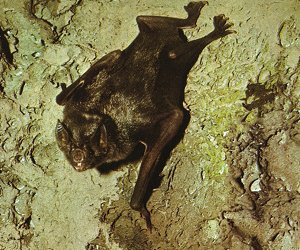 A medium-sized, dark gray-brown bat with a short, blunt muzzle; small, rounded protuberance in place of a noseleaf; the deep groove in lower lip; short ears with pointed tragus (ear flap); long, strong thumb with a short, curved claw; no tail. Length of head and body about 3″, forearm 2.4″; weight 0.6-1.5 oz.
A medium-sized, dark gray-brown bat with a short, blunt muzzle; small, rounded protuberance in place of a noseleaf; the deep groove in lower lip; short ears with pointed tragus (ear flap); long, strong thumb with a short, curved claw; no tail. Length of head and body about 3″, forearm 2.4″; weight 0.6-1.5 oz.
Behavior: Cave-dwelling common vampires roost in colonies of up to 1000, but usually about 100. They feed on blood, mainly of cattle and other livestock, often attacking the same animal night after night. Humans are seldom bitten. The bats’ large, razor-sharp upper incisors cut a small wound from which the blood is lapped through a “drinking straw” formed by grooves under the bats’ tongues and in their lower lips. Vampires transmit paralytic rabies and other livestock infections.
Reproduction: Common vampire bats breed throughout the year, bearing a single young after an 8-month pregnancy. The 2 other species of vampire bats are Diaemus young in eastern Mexico to Brazil, and the hairy-legged vampire (Diphyffa ecaudata), known from Val Verde County, Texas, to southern Brazil.
Yellow-eared bat
Yellow-eared bat – URODERMA BILOBATUM
- Class: Animals with Milk Glands (Mammalia)
- Subclass: True Mammals (Eutheria)
- Order: Hand Wing (Chiroptera)
- Family: Phyllostomatidae.
- Location: Mexico, Central America, northern South America.
- Habitat: Tropical forests.
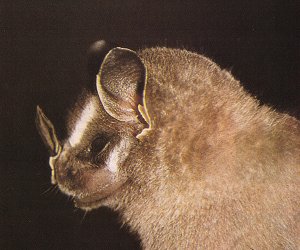 A small bat with erect, pointed noseleaf with rounded sides on a fleshy, horseshoe-shaped base; no visible tail. Pelage (fur) gray-brown with 4 white facial stripes, a median stripe down the lower back, and yellow ear margins. Length of head and body about 2.4 in, forearm 1.6 in; weight up to 0.8 oz.
A small bat with erect, pointed noseleaf with rounded sides on a fleshy, horseshoe-shaped base; no visible tail. Pelage (fur) gray-brown with 4 white facial stripes, a median stripe down the lower back, and yellow ear margins. Length of head and body about 2.4 in, forearm 1.6 in; weight up to 0.8 oz.
Behavior: The Yellow-eared bat subsists on a wide variety of tropical fruits and consumes insects as well. Solitary individuals, or small clusters of 10 or more, roost by day in tree hollows or more often under the broad leaves of banana plants or palm trees. Like many tropical bats, they remain alert while resting. Unlike most bats, which make no nest or shelter of any sort, the tent-making bat is known to cut a row of small holes in a palm frond so the edges droop, forming a sort of tent under which the bat hangs. Bats of a closely related Neotropical genus, and a distantly related genus of fruit bats in Sri Lanka, have similar roost-making habits.
Reproduction: A single young is usual; peak periods of birth are March-April and July-August.
Yellow-winged bat
Yellow-winged bat – LAVIA FRONS
Possibly Endangered
- Class: Animals with Milk Glands (Mammalia)
- Subclass: True Mammals (Eutheria)
- Order: Hand Wing (Chiroptera)
- Family: Megadermatidae.
- Location: Eastern Africa.
- Habitat: Lowland savanna and open woodlands near water; occasionally riverine gallery forests.
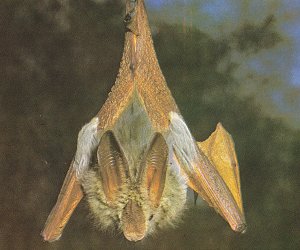 Similar to Megaderma but with bright yellow or orange wings and ears; bluish fur. Enormous ears with long, forked tragus (ear flap); tall, pointed noseleaf. Length of head and body 2.4-3.2 in, forearm 2.2-2.5 in, weight 1.2-1.4 oz.
Similar to Megaderma but with bright yellow or orange wings and ears; bluish fur. Enormous ears with long, forked tragus (ear flap); tall, pointed noseleaf. Length of head and body 2.4-3.2 in, forearm 2.2-2.5 in, weight 1.2-1.4 oz.
Behavior: This strikingly colored bat is most abundant in open country around lakes, marshes, rivers, or the sea, below 6700 feet elevation. In pairs or groups at 4 or 5, yellow-winged bats roost by day in bushes and trees, sometimes in direct sunlight; with their faces covered with their wings, they look like dry leaves. They are restless and will change roosting sites during broad daylight. They feed at dusk and during the night. The bat hangs on a low branch in the open. Very alert, it sees or hears an insect on the ground or flying, swoops down and captures it, and returns to the roost to eat its catch leisurely. Large and small insects, including moths and butterflies, beetles, grasshoppers, flies, and mosquitoes, are its prey.
Reproduction: Following a gestation of about 3 months, most births of the single offspring occur in April.
Bat Fun Facts
A baby bat can weigh up to 30% of its mother’s weight at birth. This is equivalent to a 120-lb. woman delivering a 40-lb. baby!
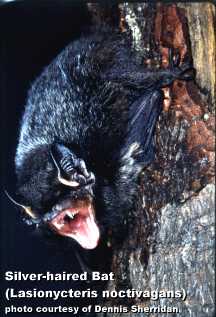 A Malayan naked free-tail bat can emit an echolocation call of 145 decibels. That is equivalent to a jet airplane at takeoff.
A Malayan naked free-tail bat can emit an echolocation call of 145 decibels. That is equivalent to a jet airplane at takeoff.
Some echolocating bats shut their ears “off” up to 200 times a second in order not to deafen themselves with their own calls. They must then turn their ears back “on” up to 200 times a second in order to hear the incoming echo.
Bats can live 30 years or longer. The record for longevity in the wild is held by two brown bats (Myotis lucifigus) in Canada that lived more than 42 years.
Bats vary in size from the tiny Kitti’s hog-nose bat of Thailand, which weighs less than a penny, to the Indian flying fox of India, with an average wingspan of 6 feet. Most of the world’s bats are so small they could be mailed with one first-class stamp.
Hoary bats have flown from the mainland of North America to Hawaii, a distance of almost 3,000 miles over the open ocean. These incredible flyers are now Hawaii’s only indigenous land mammal and are listed as endangered.
Four hundred fifty cash crops around the world depend on bats for pollination and/or seed dispersal.
Up to 98% of the seeds dropped in cleared areas in tropical rainforests are dispersed by bats, making these animals critical to tropical reforestation efforts.
Common Misconceptions about Bats
Bats get stuck in your hair.
No, bats do not get stuck in your hair. Bats will fly close to your face while catching insects that are attracted to your breath, but bats are not interested in your hair.
Bats attack people.
Although bats sometimes swoop close by you in the evening, bats do not attack people. They are gentle, passive creatures that will only bite in self-defense if they are picked up and handled.
All bats have rabies.
Like all mammals, bats can contract rabies, but only about 1 in 1,000 bats will become infected with this disease. Bats do not have outbreaks of rabies, because individual bats who contract rabies will separate from the colony and fall to the ground. This is why it is vital not to handle any bat you find lying on the ground. It is very likely to be sick.
Bats are rodents.
No, bats are not rodents. In fact, they are more closely related to humans than they are to mice and rats. Unlike rodents, bats reproduce very slowly, bearing only one or two young per year, they can live up to 30 years or more, and they do not chew wood or insulation. Bats are not vermin; rather, their presence is an indicator of a healthy ecosystem.
